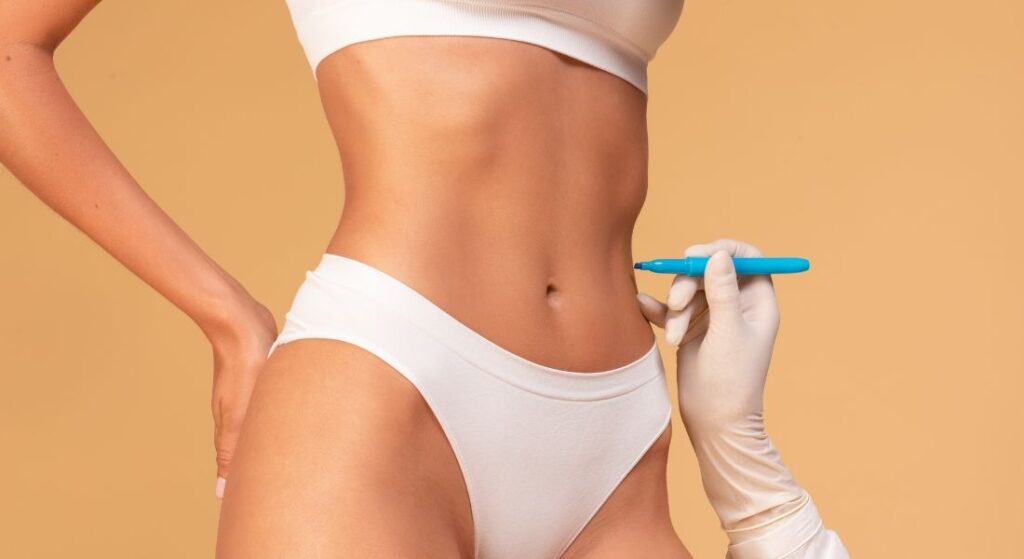
If you’re considering Sculptra, you’re probably wondering how much product you’ll actually need. You’ve likely heard numbers like “one vial per decade of age” or “ten vials for a BBL” but what do these really mean?
The truth is, there’s no one-size-fits-all answer. The number of vials needed depends on your treatment area, skin condition, desired results, and even your body’s collagen response.
In this guide, we’ll explain how Sculptra dosing works, what typical treatment plans look like for the face, buttocks, and hip dips, and how to know what’s right for you.
Understanding What a Sculptra Vial Is
Before talking numbers, let’s look at what’s inside a vial.
Each vial of Sculptra contains poly-L-lactic acid (PLLA) a biodegradable compound that stimulates your body to produce its own collagen. It’s not a filler in the traditional sense. Instead of adding instant volume, it rebuilds your skin’s foundation gradually from within.
When mixed and reconstituted, a vial becomes a liquid solution that is carefully injected into target areas to activate collagen production.
– 1 vial = 5ml after reconstitution
– Each vial is diluted with sterile water and sometimes lidocaine for comfort.
– Results appear over 8–12 weeks, improving skin texture, firmness, and contour naturally.
So, when planning treatment, the focus isn’t just on adding volume it’s about creating a collagen framework that strengthens and rejuvenates the area over time.
Why the Number of Vials Varies

Sculptra’s results depend on how much collagen your body can generate. Some people see noticeable improvement after two vials, while others need several sessions to reach their goal.
Several factors influence this:
1. Treatment Area:
Larger areas like the buttocks or thighs naturally require more product than smaller zones like the temples or jawline.
2. Skin Thickness and Age:
As collagen production decreases with age, more product may be required to achieve visible stimulation.
3. Desired Outcome:
Are you seeking subtle rejuvenation or a more lifted, contoured look? Your aesthetic goal defines your plan.
4. Metabolism and Lifestyle:
High metabolic rates, smoking, or excessive sun exposure can reduce longevity, affecting the number of vials needed for maintenance.
5. Injector Technique:
Dilution ratios and injection depth differ between practitioners. An experienced injector tailors these to your unique anatomy.
How Many Vials of Sculptra Do You Need for the Face?
When it comes to facial rejuvenation, the goal with Sculptra isn’t to overfill your face it’s to gradually rebuild the youthful structure you’ve lost over time.
If you’re in your 30s, you’ll typically need around one to two vials in total, often spread across one or two sessions. This is usually enough to refresh your skin and maintain subtle volume without looking overdone.
By your 40s, collagen loss becomes more noticeable, so most people benefit from two to three vials over two to three treatment sessions. This helps restore midface support and definition.
If you’re 50 or older, your skin may need three to five vials in total, usually delivered over three or more sessions for a natural, lifted appearance.
Example Treatment Plan:
– First session: 2 vials for cheeks and jawline.
– Second session (8 weeks later): 1–2 vials for temples and marionette lines.
– Optional third session: Refinement and symmetry correction.
Patients typically notice smoother contours, firmer skin, and subtle lifting within 2–3 months.
Common Facial Areas Treated with Sculptra

Sculptra can be used across multiple facial zones to improve volume and support:
1. Cheeks: Restores mid-face fullness and lift.
2. Temples: Smooths hollowing for a balanced upper face.
3. Jawline: Defines and sculpts for a youthful contour.
4. Marionette Lines: Softens folds without looking puffy.
5. Nasolabial Folds: Rebuilds collagen to reduce depth gradually.
Each area typically requires 0.5–1 vial per side, depending on the degree of volume loss.
How Many Vials for the Buttocks (Sculptra BBL)?
The Sculptra Butt Lift, often called the Sculptra BBL, has become one of the most popular non-surgical body enhancement treatments. Because the buttocks are a large, dense area, they naturally require more product than the face to achieve visible contouring and lift.
If your goal is a mild lift or smoother shape, you’ll usually need around 6 to 8 vials per session, with two sessions spaced several weeks apart.
For those wanting a moderate increase in volume or roundness, most practitioners recommend 10 to 12 vials per session, spread over two to three treatments.
If you’re aiming for a significant lift or projection, expect to need around 16 to 20 vials, often delivered over three or more sessions for the best, most natural-looking results.
Each session is typically spaced six to eight weeks apart, allowing your body time to build new collagen. Remember, Sculptra doesn’t create instant volume instead, it gradually firms and shapes your buttocks over time. The result is a subtle, lifted appearance that enhances your natural curves without the downtime or risks associated with surgical BBLs.
Why So Many Vials?
Larger muscles and thicker tissue in the gluteal area require more product to stimulate collagen evenly. Each vial covers only a small section, so multiple vials are needed for balanced, symmetrical enhancement.
Think of it as painting a large canvas the bigger the area, the more product required for uniform coverage.
How Many Vials for Hip Dips?
Hip dips those natural inward curves along the sides of your hips are completely normal. Still, if you’d like a smoother, rounder silhouette, Sculptra can help by gradually building soft, natural-looking volume while improving skin firmness.
For a mild correction, most people need around 4 to 6 vials of Sculptra, typically spaced over two treatment sessions.
If you’re aiming for a moderate filling effect, your practitioner may recommend 8 to 10 vials over two to three sessions, depending on your shape and how your body responds to collagen stimulation.
For a fuller, more contoured look, you’ll likely need 12 or more vials, often spread across three or more sessions for a smooth and even result.
Each side of the hips is treated evenly to maintain balance and avoid irregularities. Over time, as your body produces new collagen, the treated area becomes naturally fuller and more sculpted without any artificial feel or sudden change.
Sculptra for the Body (Other Areas)

Sculptra isn’t just for your face or buttocks it can also rejuvenate and firm other parts of your body where skin tends to lose elasticity over time.
If you want to refresh your décolletage, one to two vials per session are usually enough to soften fine lines and reduce that crepey look that often appears on the chest.
For the upper arms, most people need around two to four vials. This helps firm up areas where the skin has become thin or slightly loose, especially after weight loss or ageing.
The abdomen often requires about four to six vials per session. It’s an excellent choice for improving skin laxity, whether it’s post-pregnancy or simply due to natural collagen loss over the years.
If your concern is the thighs, you may need between four and eight vials. Sculptra works here to tighten and smooth the skin, giving a firmer, more even texture.
For the knees, where crepey skin can develop with age, one to two vials can help restore smoother, more youthful-looking skin.
No matter the area, the treatment works gradually stimulating your body’s collagen production for subtle, long-lasting improvements in tone, texture, and firmness.
How Collagen Production Affects Dosage
One of the key things to understand about Sculptra is that it doesn’t add filler directly your own body does the work.
This means the dosage depends on how efficiently your body can build collagen in response to the PLLA stimulus.
Factors influencing collagen response include:
– Age and genetics
– Protein intake and hydration
– Lifestyle (sleep, alcohol, sun exposure)
– Skin health and metabolic rate
Patients who maintain healthy habits and consistent skincare typically enjoy longer-lasting and more pronounced results.
Session Frequency and Maintenance
Sculptra is not a one-time treatment. It’s best thought of as a progressive investment in your skin quality and structure.
– Initial phase: 2–3 sessions spaced 6–8 weeks apart.
– Maintenance: 1 session every 12–18 months.
Over time, as collagen builds and stabilises, you’ll require fewer vials per session to maintain your result.
Cost Overview
The cost of Sculptra treatment varies depending on how many vials you need, the expertise of your practitioner, and the clinic’s location.
At LMA Clinic, every treatment plan is customised after a thorough consultation to match your goals and anatomy. Still, here’s a general idea of what you can expect:
If you’re treating your face, most people need between two and four vials, which typically costs around £800 to £1,600 in total.
For the buttocks, where higher volumes are required, you can expect to use ten to twenty vials, with prices ranging from £3,000 to £6,000 depending on your desired lift and contour.
If you’re targeting hip dips, you’ll usually need six to ten vials, bringing the overall cost to roughly £1,800 to £3,000.
For body tightening treatments such as the abdomen, thighs, or upper arms you might need anywhere from two to eight vials, costing around £600 to £2,400.
Keep in mind these figures are estimates. The total price can vary based on how your practitioner dilutes the product, the specific areas treated, and the level of collagen stimulation you’re aiming for.
How Long Will My Results Last?
Unlike dermal fillers that dissolve after several months, Sculptra results are long-lasting because they rely on your natural collagen production.
You can expect improvements to last:
– 18–24 months for facial rejuvenation.
– Up to 3 years for body areas like the buttocks or thighs.
Results fade gradually, so touch-ups are recommended every year or two to maintain your best outcome.
The Consultation Process
Your treatment journey begins with a thorough consultation at LMA Clinic. During this, your practitioner will:
1. Assess your anatomy – understanding volume loss, asymmetry, and skin quality.
2. Discuss your goals – from subtle lift to enhanced shape.
3. Create a bespoke plan – outlining the number of vials, sessions, and timeline.
4. Explain aftercare and expected results – so you know exactly what to expect.
This approach ensures your treatment looks natural and fits your body harmoniously.
Why You Should Avoid Guessing or Self-Comparing
Every patient’s collagen structure and response are unique. Comparing your vial count with someone else’s is rarely accurate.
A friend may have needed 6 vials for her hips, while your anatomy or collagen response may require 10 and that’s perfectly normal.
Over- or underestimating your dosage can affect results. Too few vials may lead to underwhelming volume, while overuse may risk uneven texture.
That’s why an individualised consultation with a qualified professional is essential.
How Sculptra Compares to Other Fillers
Unlike traditional hyaluronic acid (HA) fillers, which give you instant volume by placing a soft gel beneath the skin, Sculptra works differently. It stimulates your body’s natural collagen production, helping your skin gradually regain firmness and structure over time.
The main ingredient in Sculptra is poly-L-lactic acid, a biostimulatory substance that encourages your own collagen to form. In contrast, HA fillers rely on hyaluronic acid, a hydrating molecule that physically fills out lines and hollow areas.
Because of this difference, the results timeline also varies HA fillers deliver immediate improvement, while Sculptra’s effects appear more gradually over six to twelve weeks as new collagen develops.
Sculptra’s longevity is another advantage. Its results typically last two to three years, compared to around six to twelve months for most HA fillers.
So, while HA fillers are great for quick touch-ups or precise contouring, Sculptra shines when your goal is full-face rejuvenation or enhancing larger areas with subtle, long-lasting volume and improved skin quality.
Key Advantages of Proper Vial Planning
1. Consistency: Predictable, even collagen stimulation across all treated areas.
2. Longevity: Gradual treatment produces longer-lasting collagen formation.
3. Customisation: Vials are adjusted for your unique anatomy and collagen potential.
4. Safety: Balanced dosing reduces the risk of nodules or overcorrection.
When planned carefully, your treatment delivers a smooth, natural transformation rather than sudden or uneven changes.
FAQs:
1. How many vials of Sculptra will I need for my first treatment?
The number of vials you’ll need depends on your age, treatment area, and the results you’re hoping to achieve. If you’re treating your face, most people start with about one to two vials in their first session. For larger areas like the buttocks or hips, you might need anywhere between six to ten vials per session. Your practitioner will evaluate your skin’s condition, the level of volume loss, and your overall goals to create a customised plan. It’s never a one-size-fits-all approach, so a proper consultation is the only way to know exactly how many vials are right for you.
2. Why do some people need more vials than others?
Everyone’s body responds differently to Sculptra because collagen production varies from person to person. If your skin is thinner, more mature, or has more volume loss, your practitioner may recommend additional vials to achieve balanced, visible results. Lifestyle factors also play a role things like smoking, sun exposure, and even metabolism can affect how well your body responds to the treatment. Essentially, the more collagen support your skin needs, the more vials may be required.
3. How long does it take to see results after Sculptra?
Unlike traditional fillers that give instant results, Sculptra works gradually as it stimulates your body to produce new collagen. Most people start to notice subtle improvements in texture and firmness about six to eight weeks after their first session. The full effect usually appears around three to six months later as your collagen network strengthens. The results build over time, giving you a more natural, refreshed look rather than an overnight transformation.
4. How long do Sculptra results last?
Sculptra results are long-lasting because they rely on your body’s own collagen production. Once your collagen has rebuilt, you can expect the results to last up to two years for facial treatments and even longer around three years for larger body areas like the buttocks or thighs. The longevity also depends on how well you care for your skin, your general health, and whether you follow the recommended maintenance schedule. Most people choose to have a top-up session every 12 to 18 months to keep their results consistent.
5. Is Sculptra safe?
Yes, Sculptra is considered very safe when administered by a trained and qualified professional. The main ingredient, poly-L-lactic acid (PLLA), has been used in medical applications for decades and is fully biodegradable. It’s gradually absorbed by your body as it stimulates collagen production. Side effects are typically mild and temporary, such as slight redness, swelling, or tenderness at the injection site. The key to safety is always choosing an experienced injector who understands correct placement and dilution techniques.
6. Can I combine Sculptra with other treatments?
Absolutely. Many people choose to combine Sculptra with other cosmetic treatments to enhance their results. For example, hyaluronic acid fillers can be used for areas that need immediate volume or definition, while Sculptra works behind the scenes to improve overall skin quality and firmness. It also pairs well with treatments like microneedling or laser therapy, which can further boost collagen production. Your practitioner can recommend the right combination based on your aesthetic goals and treatment timeline.
7. How much downtime should I expect after a Sculptra session?
One of the great advantages of Sculptra is that downtime is minimal. You might experience some mild swelling, tenderness, or bruising for a few days, but most people return to their normal activities right after treatment. It’s recommended that you avoid strenuous exercise, saunas, or direct sun exposure for at least 24 to 48 hours. Your practitioner will also ask you to massage the treated areas for five minutes, five times a day, for the next five days to help the product distribute evenly.
8. What happens if I use too few or too many vials?
Using too few vials can result in under-correction, where the treatment doesn’t provide enough collagen stimulation to make a visible difference. On the other hand, using too many vials in one area can cause uneven results or small nodules under the skin. That’s why precise vial planning by an experienced injector is crucial. During your consultation, your practitioner will assess how much product you’ll need for balanced, natural-looking results that suit your face or body proportions.
9. Can Sculptra be used for skin tightening only, without adding volume?
Yes, it can. While Sculptra is known for its volumising effect, it’s also highly effective for improving skin tone and firmness. If your main goal is tighter, smoother skin rather than adding fullness, your injector can adjust the dilution ratio to focus on collagen stimulation rather than volume. This technique works well for areas like the neck, chest, arms, and abdomen, where skin laxity is a concern but additional volume isn’t needed.
10. How do I know if Sculptra is right for me?
You’re likely a good candidate for Sculptra if you want gradual, natural-looking rejuvenation without the downtime of surgery or the instant plumpness of fillers. It’s ideal if you’re noticing early signs of ageing, such as loss of firmness or contour, or if you want to enhance body areas like the buttocks or hips without implants. However, if you’re pregnant, breastfeeding, or have certain autoimmune conditions, you may need to wait before undergoing treatment. The best way to find out is to book a consultation where your practitioner can review your goals, medical history, and suitability in detail.
Final Thoughts: Planning Your Ideal Sculptra Treatment
Determining how many vials of Sculptra you need isn’t about sticking to a rule of thumb it’s about crafting a treatment plan that aligns with your goals, skin quality, and natural collagen response. While general guidelines can help you estimate, only a professional consultation can truly tailor the dosage to your needs.
At the London Medical & Aesthetic Clinic, every treatment is overseen by Dr Ayham Al-Ayoubi, a world-leading expert in aesthetic medicine and advanced injectables. His precision and experience ensure your results are natural, balanced, and long-lasting whether you’re seeking subtle facial rejuvenation or enhanced body contouring.
If you’re considering Sculptra in London, you can book a consultation with Dr Al-Ayoubi to explore your options and discover how this collagen-stimulating injectable can help you achieve firmer, smoother, and beautifully lifted results that develop gradually and look entirely natural.
References:
1. Shridharani SM et al. (2021) ‘Clinical experience of poly-L-lactic acid injections for body contouring’, Aesthetic Surgery Journal, 41(3), pp. 279-289. Available at: https://pubmed.ncbi.nlm.nih.gov/33830621/
2. Carvalho PP et al. (2024) ‘Effectiveness and safety of Sculptra® poly-L-lactic acid injectable treatments in facial aesthetics: a 12-month retrospective study’, Journal of Drugs in Dermatology, 23(1), pp. 1297-1305. Available at: https://pubmed.ncbi.nlm.nih.gov/38206151/
3. Loureiro W et al. (2022) ‘Collagen Stimulators in Body Applications: A Review Focused on Poly-L-Lactic Acid (PLLA)’, Clinical, Cosmetic and Investigational Dermatology, 15, pp. 425-439. Available at: https://www.ncbi.nlm.nih.gov/pmc/articles/PMC9233565/
4. Kim S-A et al. (2022) ‘Poly-L-Lactic Acid Increases Collagen Gene Expression and Synthesis in Cultured Dermal Fibroblast (HS68) Through the p38 MAPK Pathway’, Journal of Cosmetic Dermatology Science & Application, 12, pp. 20-27. Available at: https://www.ncbi.nlm.nih.gov/pmc/articles/PMC10177436/
5. Signori R, da Silva AM, et al. (2024) ‘Efficacy and Safety of Poly-l-Lactic Acid (PLLA) in Facial Aesthetics: A Systematic Review’, Polymers, 16(18), 2564. Available at: https://www.mdpi.com/2073-4360/16/18/2564





